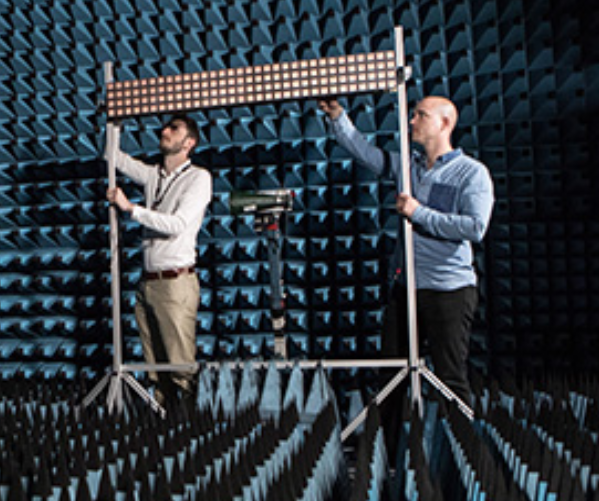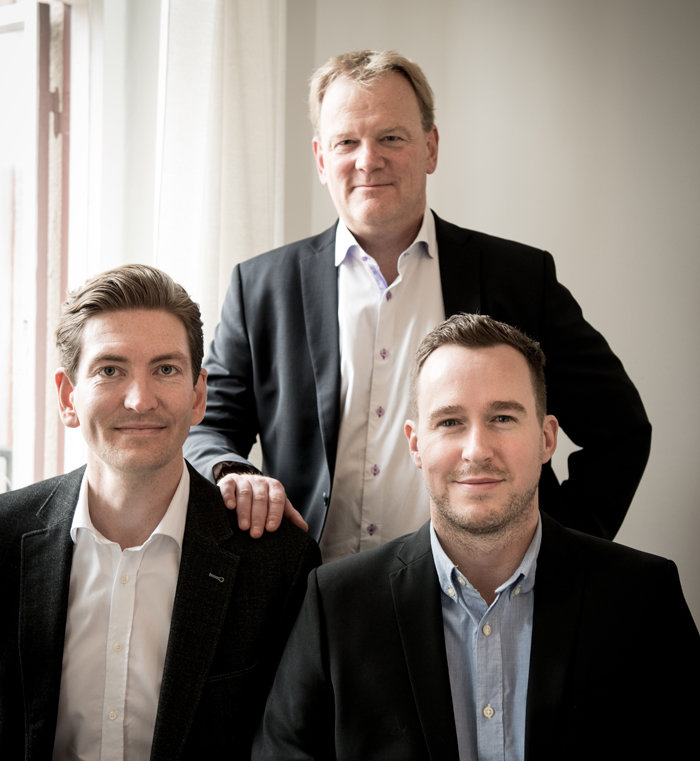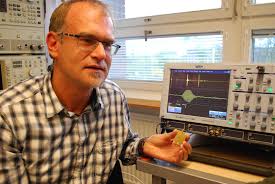News archive, 2016
Her nanomodels complies with nanoreality
Published: 2016-12-27
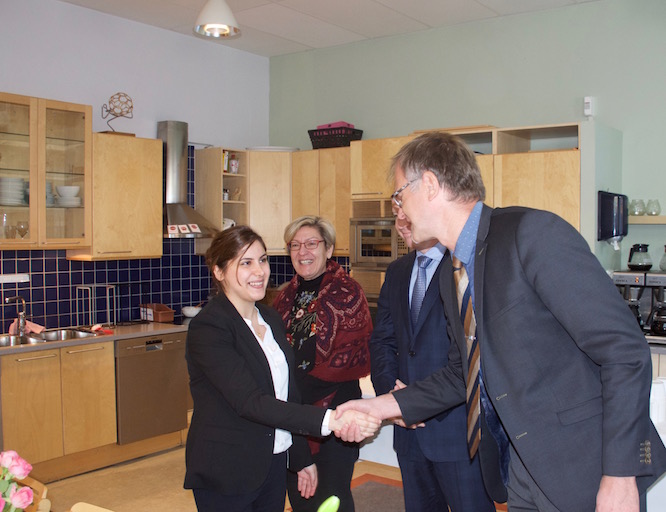
Aein S, Babadi with main supervisor Lars-Erik Wernersson
Modeling and measuring on nanostructures
-I wasn't sure if you meant quarter past or 2 sharp, says Aein Shiri Babadi after a gentle knock on the door. We have agreed on a short chat about her recent disputation and Lund academy time behaviour manners (akademisk kvart) is still not easy to get a grip on. As for many.
Aein did her PhD-research within the field of modeling, building and measuring III-V nanostructures and her PhD graduation took place Nov 11, 2016. The thesis title was "Electrical Characterization of III-IV Nanostructures".
InAs and GaSb instead of good old Silicon
-My research is related to fabrication of transistors, she says. I'm doing material characterization for MOSFETs where my work is related to the material synthesis, electrical characterization and also modeling of these tiny devices. A general focus in the group, headed by Lars-Erik Wernersson, is on III-V nanostructures and the first part of my work was on Indium Arsenide (InAs) and integration of high dielectric constant oxides on InAs. The second part was to do electrical characterization of electrical properties of nanowires from InAs and Gallium Antimonide (GaSb).
Nervous before it complied
Are you a theoretical or an experimental researcher? - I have been lucky and had opportunities to get experiences in both areas, says Aein. I have also applied the models I made on devices that I fabricated with different growth conditions with the thin oxide layers. Theory, models, fabrication, experiments and comparison. -We did the whole lot, she says enthusiastically! And it compared well. -Some anxiety on how it would compare has been around during my work, Aein admits. First years with modeling took a lot of my time and I really felt pressured to get it ready. Eventually the model compared quite well to the experiments and we presented and also got it awarded at a conference in Ireland! Good feeling!
Size, mobility and power is what counts
-My findings can be applied to improve the gate performance of the transistors, Aein responds to the question as "what is this good for?". - For high-performance scaled MOSFETs, the gate oxide has to be appropriately scaled with an equivalent oxide thickness, EOT, below 1 nm to achieve strong gate control over the electrostatic potential inside the semiconductor. Achieving a high-quality gate requires a high dielectric constant oxide layer free of defects, which is scaled in thickness with few interfacial imperfections at its interface with the semiconductor material. This is important to lower power consumption that is a never-ending strive.
From Persian Gulf city to nanolab in Lund
-I'm from a city at the southwest of Iran, Ahvaz, an industrial million-city close to the Persian Gulf. I grew up there where I also did my university bachelor education. After that I lived in Tehran for a year. -My parents have always encouraged me to take studies seriously so I went further and looked for research study opportunities, she continues. I did my masters in physics at the faculty of Natural Sciences in Lund where I chose the direction of nanoelectronics after attending a course by Lars-Erik Wernersson. -Lars-Erik is to blame for attracting me into this area, says Aein with a smile. After masters graduation I got an opportunity to join the group, a thing that I don't regret.
Hopefully post-doc
-I'd like to do a post-doc program so I could widen my research experience into new directions. I have made some applications for funds and I keep my fingers crossed. I will probaly end up in in another university and perhaps in another country if all goes according to plans.
Inspiring research environment at EIT
Sweden and Lund has been enjoyable. Also EIT has been a nice working environment and people around me have been very good in all respects. The departments other research areas like communications and circuit design have also been inspiring while thinking about where my research could be applied.
Gender balance, could be better but not too bad
Gender perspective is an important area in general and discussed a lot nowadays. Is the male-dominated world at EIT something you think about? -I got used to it after a while, but of course, I must admit that it is always good to have some female colleagues as well, says Aein. To be honest, for most part of my PhD study I have not been alone as a women here. In the mid part of my studies we were 4 women (PhD and postdocs) in Lars-Eriks group. That was good for all of us, men and women.
Other good things in life?
I do painting if there is a spare minute. Water colours with sceneries, flowers, leaves and more. But no faces. Too difficult!
And last, how was the christmas food at Ringsjö Värdshus? Did you eat everything?
-Yes! I like swedish food. And I cook myself also but neither Iranian or Swedish type rather my own culture. I make up the dishes myself, Aein says with a smile. It's time thats precious, fast forward is key.
And now, fast forward to some days off and relaxing.
Congratulations from EIT!
Text and Photo: Anders Borgström
MAPCI blir statligt forskningsinstitut
Published: 2016-12-16
Forskningsinstitutet MAPCI knoppas av från Lunds universitet och blir ett fristående institut under RISE ? svenska statens ägarbolag för forskningsinstitut. Förändringen är beslutad av MAPCI:s ägare och sker vid årsskiftet. Samtidigt justeras...
? Redan när vi startade MAPCI för tre år sedan hade vi planer på att låta institutet bli fristående och jag är glad att alla nuvarande finansiärer gjort det möjligt för oss att nu sätta den planen i verket. Med RISE i ryggen får vi kraft att stärka de såväl nationella som internationella strukturerna, säger Bengt-Arne Molin, ordförande för MAPCI.
MAPCI står för Mobile and Pervasive Computing Institute at Lund University och bildades 2013 av Lunds universitet, Region Skåne och Sony Mobile Communications. Sedan starten har även Ericsson tillkommit som institutets fjärde finansiär.
Fokusområde för institutet är mobil teknologi och digitalisering av industri och samhälle. Det mobila ekosystemet runt MAPCI bygger på regionens styrka inom utveckling av system, programvara, hårdvara samt mobila och trådlösa system.
Nu blir verksamheten ett institut inom RISE ICT. RISE står för Research Institutes of Sweden och är statens ägarbolag för industriforskningsinstitut. Nuvarande intressenter blir kunder istället för finansiärer. Fokus kommer fortfarande vara på uppkoppling i olika former, men nu tillkommer hälsa som ett specifikt område.
? Genom våra grundare, finansiärer och inte minst Lunds universitet har vi snabbt kunnat komma igång och etablera en stark forsknings- och innovationsportfölj. Nu ser vi med spänning på framtiden och tack vare vår starka plattform är jag övertygad om att vi kommer att få se många givande resultat framöver, säger Björn Landfeldt, föreståndare för MAPCI.
Totalt får institutet 16 miljoner kronor i stöd under tre år. Region Skåne går in med 9 miljoner kronor för särskilda projekt, med prioritet på mobil hälsovård och omsorg. Lunds universitet satsar inte nya pengar i det nya institutet men istället för att ta in 7 miljoner kronor från övriga parter i samarbetet med MAPCI låter man pengarna övergå direkt till det nya institutet.
MAPCI håller till i Mobile Heights Center i nordöstra Lund, i nära anslutning till Lunds Tekniska Högskola, Ericsson och Sony Mobile Communications. Totalt sysselsätter MAPCI omkring 25 personer och har en årlig budget på 10-15 miljoner kronor. Förutom forsknings- och innovationsprojekt driver institutet även det öppna innovationslaboratoriet MAPCI Innovation Lab.
RISE Research Institutes of Sweden är det gemensamma varumärket för svenska industriforskningsinstitut. I dag ingår 16 institut i RISE. SICS South är arbetsnamnet på den nya verksamheten planeras bli ett forskningslabb inom SICS - ett institut inom RISE, som sedan 2009 bedriver forskning- och utvecklingsverksamhet i Lund.
Läs pressmeddelande från RISE
Läs pressmeddelande från Lunds universitet
Läs mer om bakgrunden till en nationell nod för uppkopplad hälsa
Link to the article MAPCI blir statligt forskningsinstitut
A new in-house IEEE Fellow. Congratulations Fredrik!
Published: 2016-12-12

Professor Fredrik Tufvesson, IEEE Fellow
A mail, yes!
You get an email, EITs Professor Fredrik Tufvesson says with a smile when asked about how he got to know about his appointment as an IEEE Fellow. It's not more solemn than that, although it is a rather exclusive group now Fredrik joins. Less than 0.1% of the voting members are elected annually to elevate to this level. LTH and EITs newest Fellow membership takes effect on 1 January 2017. The motivation reads "... for contributions to measurement and modeling of wireless propagation channels ...". The department's research findings in the channel propagation really propagate, for sure.
Good rating for EIT research
When asked about the process towards fellowship, Fredrik tells us he was nominated and then six other IEEE Fellows thought it was a good idea. And they then made it all clear by writing letters of support. -But I was not involved myself in the process, even though I knew about the nomination, says Fredrik. After support letters follows the evaluation and appointment. The IEEE Fellowship is significant not only for the person but also for his research, colleagues and LTH / EIT.
-Good score for all of this I would say, continues Fredrik. It is a confirmation that we are doing the right things and we do them well. We contribute in important ways to the scientific community with relevant research.
Fredrik, John B and a few others
How many fellow-fellows do you have at LTH?
-Not many but we have been a few. Rolf Johannesson is one. Last year our ELLIIT-colleague and Linköping professor Erik G Larsson got appointed and this year LTHs Leif Sörnmo joined the group.
And we have of course John B. Anderson, emphasizes Fredrik. He has recently changed its academic status to professor emeritus, which means that he will not have formal duties anymore. He will therefore perhaps allocate more of his time to United States. But he likes to work in general and for us in particular. John B, as he is called in the corridors, have been here throughout my entire time and been a great source of inspiration, says Fredrik. We hope it stays that way for a while.
The fellowship program only exist within the activitiy areas of IEEE and to be elevated it requires a strong seniorship and significant contributions to the actual field of research. In Fredriks case we are tallking about wireless communication.
So, do you expect new duties and hard work now?
-Nope. But again, it's very inspiring for myself and good for the organisation with confirmation on what we achieve here. Hopefully we will bring forward more IEEE Fellows in the future.
Congratulations!
Text and photo: Anders Borgström
More spectral efficiency awards to the MIMO-team
Published: 2016-12-08
|
Adding to the earlier award portofolio, Steffen Malkowsky and his colleagues in the M-MIMO team also took first prize at NI Engineering Impact Awards for Northern Europe 2016 in London. University of Bristol and Lund University have together set a world record in wireless spectral efficiency using Massive MIMO technology. Congratulations!
|
.. |  |
Tobias steps up in frequencies
Published: 2016-12-08
|
Tobias Tired graduated and achieved his doctoral title Nov 9, 2016 after defending his thesis named "Integrated Transceivers for Millimeter Wave and Cellular Communication". What’s your research about Tobias? -I have designed integrated circuits for wireless communication. Receivers for mobile phones have to date used frequencies up to 2,7 GHz and homodyne technology has fully replaced the older superheterodyne technology which means filterless and cheaper solutions. -Much higher frequencies (mm-wave, 71-95 GHz) can be used for wireless communication between basestations as a fiber replacer in future systems where we will see much smaller cells and much higher number of basestations. These high bands secure bitrates of several Gbps. -Higher attenuation requires more directional antennas and my work presents designed circuits to control this electronically. I have also investigated new architectures for power amplifiers which often dominates the power consumption of an entire transmitter solution. |
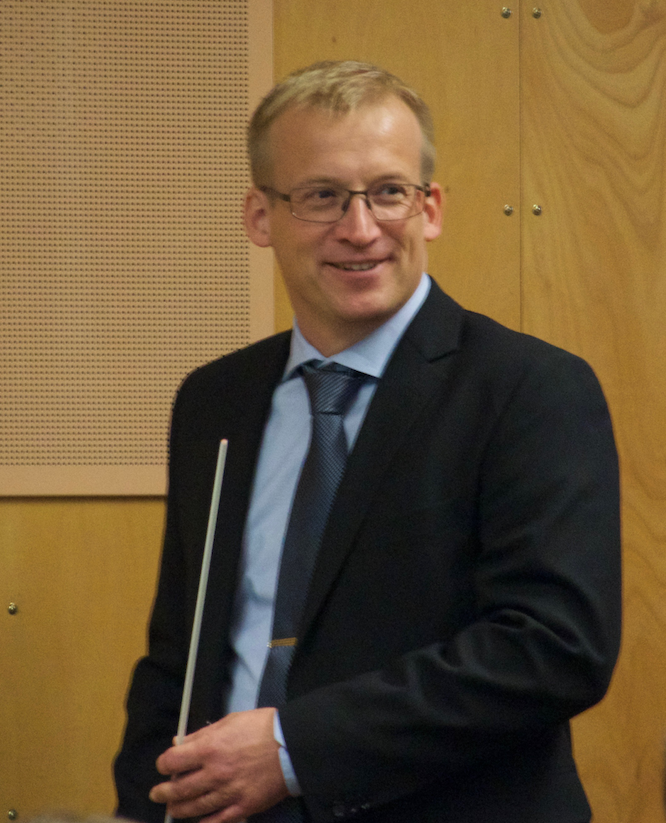 |
|
-In total, I have designed 5 circuits containing oscillators, PAs and PLLs. 4 of them have been tested and verified through experiments. My research has been financed through the VINNOVA-center System Design on Silicon (SoS). Who are you? -I grew up in Lund and have lived here all my life except for a three year stay in Stockholm when I was working at Ericsson Components. I worked almost 20 years with Ericsson before I started as a PhD-student at EIT. Between 2011 and 2012 I was an industrial PhD supervised by Pietro Andreani. Why PhD and why this field? -I have always been curious to try on the academic world. During my career at Ericsson, there was always a close cooperation with the academic research that made me curious. In the end, I took a shot that appeared in order to finalize my PhD. -It has been an exciting time more freewheeling than product development projects at Ericsson. I have had good opportunities to do research on new chip architectures. The most exciting part of my area is probably what opportunities around mm-wave technology that will be offered in the future. Not only in Telecom but also in areas such as medical technology and radar technology. -How about your future? -I have an upcoming exciting job at an IDEON startup company. It’s not about mm-waves but close to it. Congratulations from EIT!
|
EIT research highlight on phase noise.
Published: 2016-12-08
Another research highlight for EIT is delivered in IEEE Transactions on Circuits and Systems I with the paper "A General Theory of Phase Noise in Transconductor-Based Harmonic Oscillators".
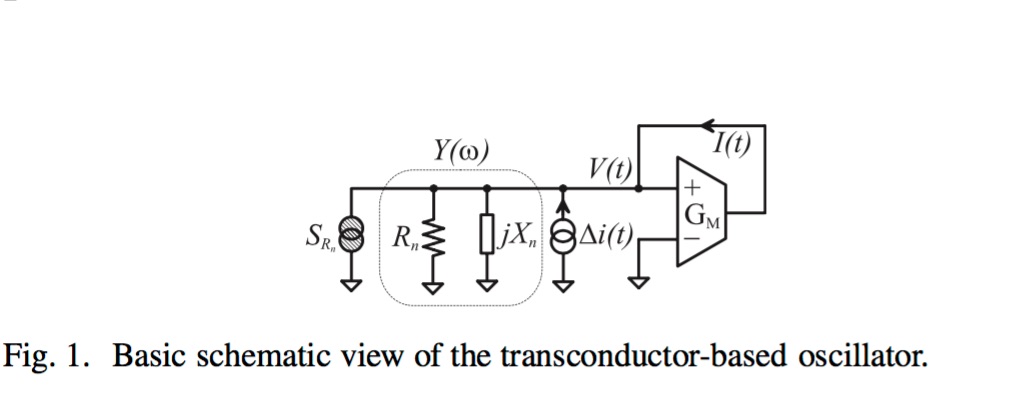
In the paper Federico Pepe and Pietro Andreani prove that, when the active core of an oscillator works as transconductor, its phase noise contribution is always proportional to that induced by the tank. As assumption is made on the specific nature of the transconductor and the tank, the result is valid in the very general case.
Congrats to brilliant EIT research!
Miljonregn och uppmärksamhet till nanoelektronikgruppen
Published: 2016-12-08

EITs Nanoelektronikgrupp vid Insightmöte.
Text och bild: Anders Borgström
EITs Nanogrupp beviljas VR anslag (konsolidator grant) på 10 MSEK med universitetslektor Erik Lind i spetsen för ansökan. Nanogruppen har via Lunds Universitet dessutom sänt ut en internationell pressrelease relaterad till deras presentation på International Electron Devices Meeting i San Francisco, http://ieee-iedm.org . Gruppens data väcker mycket stor respekt från Intel, IBM, University of Tokyo, MIT m.fl. Fantastisk PR för Lunds Universitet och EIT.
Gruppens arbete handlar om energieffektivare smarta transistorer. Professor Lars-Erik Wernersson och hans forskarteam vid nanoelektronikgruppen har utvecklat en transistorteknologi som kan användas i extremt lågförbrukande tillämpningar som t.ex. sensorer för "Internet of Things". Uppskalat har tekniken förutsättningar att spara enorma mängder energi och därmed bidra till att möta utmaningarna med att lösa framtidens energiförsörjning.
Ny mediekanal för EITs antennexcellens. Frimärke!
Published: 2016-11-02
Docent Anders J Johansson berättar:
För flera år sedan så genomfördes en serie mätningar på Grönland med utrustning framtagen på EIT. Själva mätningarna var en del av ett exjobb, och de antenner som användes kom från ett annat. Målet med mätningarna var att sutdera processer i myrmark då den fryser inför vintern, speciellt hur och när metangas pressas upp ur den. Utrustningen bestod av en vädersäkrad instrumentlåda och två antenner som stacks ned i jorden, där vi sedan studerade hur väl radiovågor av olika frekvenser tog sig fram genom den blöta torven.
Den exjobbare som designade antennen gick sedan vidare till att doktorera hos oss och är nu PostDoc på institutionen (Carl Gustafsson.). Exjobbaren som vi skickade till Grönland, Norbert Pirk, blev inte helt avskräckt efter ett par månaders vistelse i arktis och är idag doktorand på Geologiska institutionen, och arbetar mycket på Svalbard.
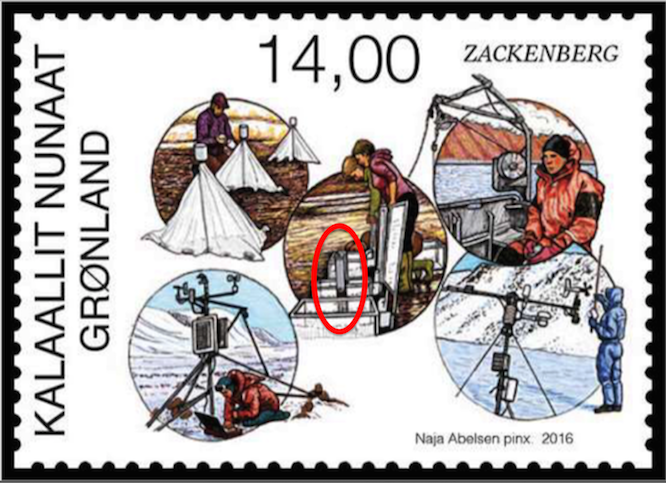
Nu har Grönlands postverk gett ut ett par frimärken som illustrerar forskningstationen, Zackenberg, på östra Grönland där mätningarna gjordes. Och av en ren tillfällighet så syns de två antenner som användes mitt på det ena frimärket.
I bilden i mitten så syns två uppstickande blå stolpar. Dessa är de glasfiberstavar vi skickade till Grönland som i nedre ändan har de antenner som användes för mätningarna av egenskaperna i marken.
Det är nog första gången som resultatet av vårt arbete syns i sådana sammanhang!
5G in Swedish National Public Radio "Ekot".
Published: 2016-11-01
Recently we heard Fredrik Tufvesson tell SR-Ekots listeners about 5G, what it is and what to expect for the users. Listen and learn. (Swedish)
Jens hjälper oss att zappa vidare
Published: 2016-10-20

Text och bild: Anders Borgström
Taggad och lugn
Fullsatt sal, blommor på bordet och presentation av avhandling på gång. Det har du upplevt många gånger, men nu var det du som stod på podiet. Hur kändes det?
-Det kändes bra, säger Jens Andersson, EITs nybakade licentiat med distribution av internetbaserad TV som specialområde. Jag var inte speciellt nervös för presentationen men lite bävan för utfrågningen fanns där såklart. Att så många kom och lyssnade är jag verkligen glad för. Det både taggade mig och gav ett lugn.

Professor Maria Kihl introducerar Jens licentiatpresentation inför fullsatt auditorium.
Färdigutbildad
Under vår pratstund berättar Jens att han och huvudhandledare Maria Kihl tidigt resonerade om att en lic-examen innan pensionen måste fixas. Så Jens skrevs in som doktorand för drygt 6 år sen och med forskning på halvtid har detta nu resulterat i examen. "Varför sluta lära sig saker bara för att man kommer upp i åren" skriver Jens i sin avhandling. Så sant som det var sagt. Aldrig försent att börja skolan.
Nya tider, nya störningar
Pixlar och frusna bilder med konstiga Kalle-Anka-ljud istället för den analoga världens gryniga bilder med knastriga röster tillhör dagens elektroniska störningsvärld. På frågan till en senior forskare som upplevt båda världarna om vilket som upplevs mest frusterande är Jens tydlig.
-Störningar nuförtiden är värre eftersom den gamla tidens störningar trots allt ofta gick att leva med. Man såg och hörde ändå nödtorftigt vad som skedde i rutan även om det blandades med myrornas krig. Och Radio Luxemburg med fading gick också att uthärda. En modern videostörning kan förvisso ge en perfekt bild men som står stilla, fortsätter Jens. Och då är det inte video.
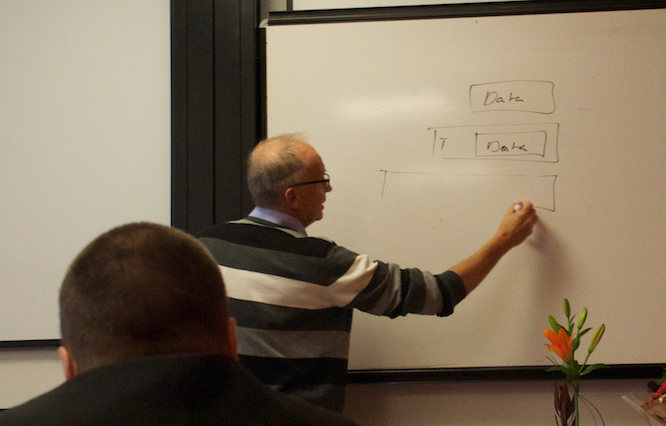
Jens försvarar sig mot opponentens frågor
Koppar biter sig kvar
Koppartrådarna ut till våra bostäder (främst villor) lever kvar trots IT-kommissionens profetior vid millenieskiftet om att fibrer skulle ut till alla. Fiberutrullningen börjar nu 15 år senare komma igång på riktigt men fortfarande finns det mycket koppar därute. Jens och hans forskarkollegor jobbar hårt på att klämma mer och mer bps (bitar per sekund) ur den begränsade bandbredd som en kopparkabel erbjuder.
-DSL (Digital Subscriber Line) med varianterna ADSL (långsammare) och VDSL (snabbare) hör väldigt mycket ihop med koppar, låter Jens oss veta. Det kan röra sig om såväl gamla telefonledningar som nyinstallerade ethernetkablar.
-Koppar kommer leva ett bra tag till, fortsätter Jens. Men det är inte så troligt att nya byggnader ansluts med koppar även om det går bra att titta på HD-TV via vanliga telefonledningar. Något som många av oss vet och som vi har forskare som Jens och hans kollegor att tacka för. Till DSL knyts även den s.k. multiple-carriers-tekniken där man istället för att använda en bärvåg som är uttrymmeskrävande använder flera och smalare bärvågor (typiskt 4 kHz breda). Dessa kan sedan moduleras på olika sätt med ett antal bitar i bitströmmen.
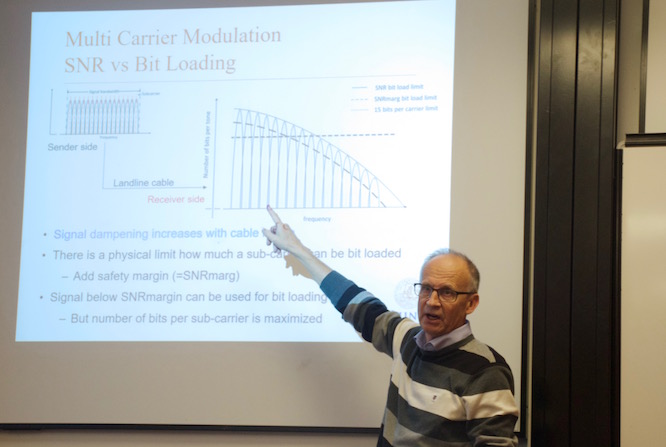
Jens förklarar vad Multi Carrier Modulation är
Kvalitet kan mätas och upplevas
QoS (Quality of Service) resp QoE (Quality of Experience) är två andra begrepp som dyker upp i Jens presentation och den senare är nog den mest intressanta och samtidigt den svåraste att hantera. QoS kan mätas instrumentellt men QoE kräver metoder med mänsklig inblandning där testpersoner måste svara på frågor om hur de upplever sitt TV-tittande. MOS (Mean Opinion Score) är t.ex. ett sätt där ett antal försökspersoner sätts framför samma TV och får svara på frågor om sitt tittande på korta snuttar.
Lära och lära ut
Är du bra pedagog Jens, frågar vi. -Det är roligt att föreläsa och det är roligt att lära ut, svarar Jens ödmjukt. Jag har tagit de enstaka kurserna på LTHs pedagogiska satsning "Genombrottet" och fått en liten grund att stå på som man får försöka använda efter bästa förmåga. Att vara akademiker betyder inte automatiskt att man är pedagog så det är bara att lära sig hur man lär ut.
Mänskligt att zappa.
Att zappa har Jens gjort till forskning på universitet. Hur zappar man, hur klarar digitala TV-tjänster av detta och vad kan göras för att minska negativ inverkan pga detta beteende i TV-soffan? Förr bytte man kanal på den analoga TV-mottagaren och så fort VCO-n svängt in sig så syntes ny bild. Idag händer det mycket i bitströmmarna innan Idol blir Mästerkocken och Aktuellt blir Sportnytt. "Riktig" TV dvs broadcast har bara en nerlänk och där är fördröjningarna vid kanalbyte relativt små eftersom bitströmmarna optimeras i själva operatörsnäten och går ut till alla noder samtidigt.
I Jens fall pratar vi om VoD (Video on Demand) och där är det användaren som bestämmer vilken bitström som ska generas just nu med Netflix, SVT-Play och YouTube som välkända exempel. Buffringsteknik, cachning m.m. ska tillsammans ge användaren ett så jämt flöde som möjligt trots störningar som kan uppstå pga av paketförluster, fördröjningar m.m. När du byter kanal så börjar du alltså buffra och slänger något som du redan laddat ner vilket sammantaget tar tid i kanalväxlingen.
Ska man designa nya TV-system för "ryckigt" TV-tittande? -Ja, säger Jens utan någon större tvekan. Vi är såna, vi människor. Jag kollar i bokhyllan utan att läsa, jag läser tidningen på rubriknivå utan att fördjupa mig i allt, jag surfar på nätet och hoppar till höger och vänster. Zappandet är i grunden samma beteende. Då kan man optimera tekniken så detta stöds. Jens resultat visar att det finns mönster i vårt zappande och hur detta kan ligga till grund för vidareutveckling av distributionstekniken för VoD. Ofta tittar man inte mer än 1 min på ett program! Paketförluster och fördröjningar i IP-trafiken är de största bovarna i kampen för att få till en bra och störningsfri TV-upplevelse när man använder sig av VoD med flitigt zappande.
Varför så många fjärrkontroller?
Till slut då, Jens, du som är TV-forskare. Tung titel f.ö.. Varför sitter många med 3-4 fjärrkontroller i TV-soffan med sammanlagt 232 knappar när de bara vill titta lite grand på TV?
-Standardiseringsproblem är antagligen den bästa förklaringen, säger Jens spontant. Företagen vill nischa sig och sälja något unikt. Många försöker sig på att skaffa så kallade multi-fjärrar men dessa har också en tröskel som man ska ta sig över med konfigurering och programmering. Ett tangentbord eller en fjärrkontroll med knappar som kan ha olika funktion kan vara ett steg på vägen. Men det är inte lätt...
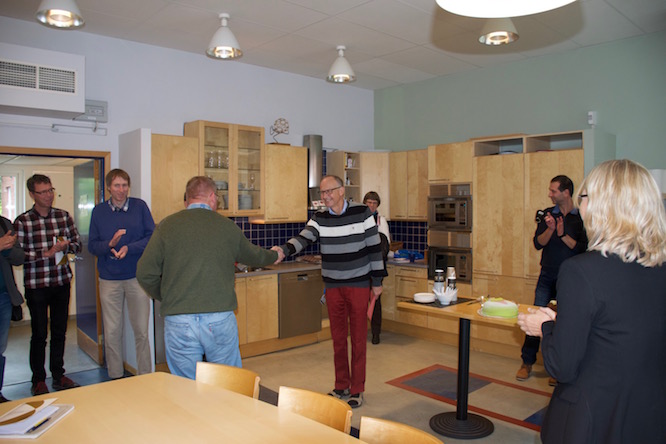
Examensbevis, applåder och tårta!
Gamla kyrkor blir som nya
Fritid? Segling, körsång och orgelspel, svarar vår nye licentiat snabbt. Teknikinnehållet i dessa grenar varierar från noll i körsången, lite lagom för seglingen med GPS, VHF m.m. till hobbyrelaterat i orgelspelandet. -Min orgel, eller VPO (Virtual Pipe Organ), innebär att jag använder samplade ljudsnuttar av olika orglars pipor i en av mig hemmabyggd elektronisk orgel. Ett program förstår tangentnedtryckningar på en klaviatur mha MIDI-kommandon, in i datorn som spelar upp ljudsnutten lika länge som jag håller nere tangenten. Hauptwerk och Grand Org är de två freewareprogram som vi orgelentusiaster använder för att simulera verkliga orglar eller sammansatta stämmor som inte finns i verkligheten. Riktigt orgelljud!
Piper vår nybakade TV-licentiat!
Grattis önskar EIT!
ELLIIT Nyhetsblad 14 ? September 2016
Published: 2016-09-30
Budgetpropositionen 2017350th anniversary in Lund with digital weekExploratory testing exploredEmelie Engström (LU/CS) received ELLIIT fundingNew web-tool for software testingFirst Massive MIMO mobility tests
ELLIIT Nyhetsblad 14 - September 2016
- Budgetpropositionen 2017
- 350th anniversary in Lund with digital week
- Exploratory testing explored
- Emelie Engström (LU/CS) received ELLIIT funding
- New web-tool for software testing
- First Massive MIMO mobility tests
ELLIIT Nyhetsblad 14 - September 2016
Link to the article ELLIIT Nyhetsblad 14 ? September 2016
Lecturing-baton passed from Mats to Vincent.
Published: 2016-09-15
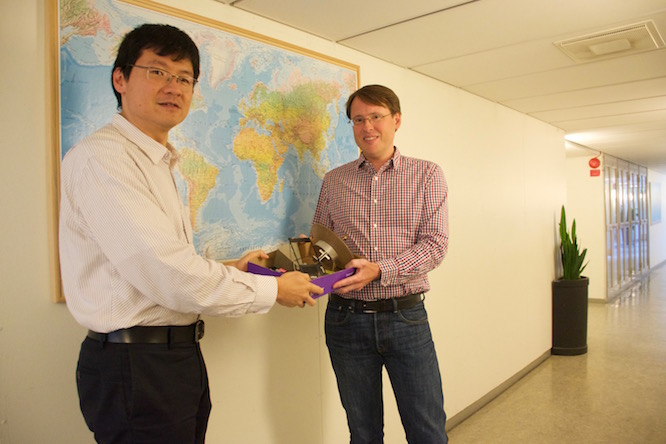
Text and photo: Anders Borgström
Professor Buon Kiong Lau (Vincent) from EIT has been appointed as a Distinguished Lecturer (DL) of IEEE Antennas and Propagation Society (AP-S) for the three-year term 2017-2019. Every year, a number of people who are eminent in the Society's field of interest, are selected to be DLs. This year, Vincent was selected together with two other experts: Prof Karu Esselle and Prof Carey M. Rappaport. DLs are financially supported to visit active so called AP-S Chapters around the world and give talks on topics of interest and importance to the AP community.
EITs other professor within this field, Mats Gustafsson, has been a DL between 2013-2015, and Vincents appointment can be seen as a continuation of our department’s involvement in this respected scientific role. Vince is passing on the baton to Mats.
A short discussion with Mats gives the following picture of what IEEE distinguished lecturing is all about.
-I did my last lectures about a year ago, says Mats. Every IEEE has its own chapters and sections where AP (Antenna & Propagation) and MTT (Microwave Theory & Techniques) are now chaired by Mats and in that role, he can invite DLs for talks at swedish universities. There is a quote system for how many DLs can be invited where IEEE pay for the expenses (T&L etc).
-EIT hosted a few lecturers last spring talking about radar and compressed sensing and also some workshops where arranged, Mats continues. -Each organisation or chapter appoints DLs where we can get in touch and ask for DLs visiting us. Our contribution is to decide a day, host them at our premises, inviting listeners and being nice to them. No cost or arrangement otherwise.
When Mats was a DL himself, he was invited to Brisbane University in Australia because his research is well-known there and in otehr places down-under. They passed the message and got in touch with other sections in Australia who also booked him up.
-I went on a 10-day lecturing tour including visits to Brisbane, Sydney, Melbourne, Adelaide and also Singapore on the way back home. -Very intense! Other "touchdowns" during his DL-period has been, among other countries, US and India and even though it's highly scientific fields the audience can vary a lot both in terms of knowledge base and numbers.
-It can be a "standard" seminar like our own internal EIT ones with 30 highly skilled listeners up to a small India university where all undergraduate students also attend counting to an overalla audience of 200 persons. -It's dynamic, says Mats. -You also need to be able to quickly adapt the abstraction level of your talks. -It's good fun and you build networks but also learn a lot about other university cultures and how they run both research and education.
The baton is passed from Mats to Vincent and we wish him successful lectures coming up and new insights in the global university world.
More information about the Distinguished Lecturer Program is found here
Startupbolag förstärker forskning om energieffektiv videoöverföring
Published: 2016-08-27
Det mångprisade startupföretaget Sensative på MAPCI Innovation Lab går in i forskningsprojektet CONVINcE. Sensatives teknik för övervakning av sensorer ska hjälpa CONVINcE-projektet att forska fram lösningar som sänker energiförbrukningen vid...
Användningen av informations- och kommunikationsteknik, ICT, fortsätter att växa kraftigt i hela världen och studier pekar på att ICT redan idag står för 10-20 procent av världens energianvändning.
Forskningsprojektet CONVINcE, som MAPCI är en aktiv del av, syftar till att göra videoöverföring på nätet mer energieffektiv, i alla aspekter ? från huvudcentraler och nätverk till slutanvändares terminaler.
? Video är en kraftigt växande del av världens media och att kunna göra just video mer energieffektiv kommer inte att bara påverka kostnaden för konsumtion av denna mediatyp utan kommer dessutom kunna påverka världens klimatutveckling, säger Björn Landfeldt, föreståndare för MAPCI.
CONVINcE-projektet har nyligen börjat ta hjälp av Lundabolaget Sensative, som utvecklar sensorer för smarta hem. Sensatives dörr- och fönstersensor ?Strips? har prisats i startuptävlingar av olika slag, säljs redan i Europa och kommer under hösten att lanseras i såväl Asien som Amerika.
För att styra Strips och andra nätuppkopplade prylar inom ramen för Internet of Things, IoT, har Sensative utvecklat en molnbaserad teknikplattform med ett öppet gränssnitt. Plattformen kallar bolaget för SHAPE (?Smarta Hem för Allmännyttan, Plattform och Ekosystem?) och har utvecklats i nära samarbete med fastighetsbolagen Helsingborgshem, Växjöbostäder och MKB.
Tekniken används normalt för att avläsa sensorer och styra belysning, dörrlås och liknande. Nu ska den istället användas för att avläsa kvalitetsinformation från wifi-routrar. Informationen analyseras sedan med hjälp av algoritmer som utvecklas på MAPCI, vilket används för att i realtid konfigurera om routrarna i syfte att förbättra prestanda för användarna.
? På så vis kan vi identifiera var någonstans i nätet som det finns problem. Lösningen kan exempelvis bestå i att byta frekvens eller andra parametrar på routrarna, kanske flytta någon router rent fysiskt eller helt enkelt sätta in ytterligare en router, säger Mats Pettersson, vd för Sensative.
Den tekniska grunden finns alltså redan, men i CONVINcE kommer man att anpassa tekniken för wifi-routrar och videoöverföring samt integrera de algoritmer som forskarna på MAPCI utvecklar.
CONVINcE är ett samarbetsprojekt mellan många olika parter. Forskarna på MAPCI fokuserar främst på konsumentsidan, bland annat på de delar av systemen som interagerar med smarta mobiltelefoner och surfplattor.
? Vi är speciellt intresserade av att kunna bibehålla eller förbättra användarens upplevelse samtidigt som vi sparar energi. Det gör vi genom att både förlänga prylarnas batterilivslängd samt genom att få placera videoinnehållet närmare användarna, vilket både förbättrar responstider och sparar energi, säger Björn Landfeldt.
Läs mer:
CONVINcE konsortium: http://convince.wp.tem-tsp.eu/consortium
CONVINcE på MAPCI: http://mapci.lu.se/research-projects/enabling-technologies/convince/
SHAPE på MAPCI: http://mapci.lu.se/research-projects/user-driven-research/shape/
Sensative: http://www.sensative.com
Hör och se forskaren Zhi Zhang berätta om Convince-projektet på MAPCI:
Link to the article Startupbolag förstärker forskning om energieffektiv videoöverföring
Multiple awards to spectrum world champions
Published: 2016-08-09
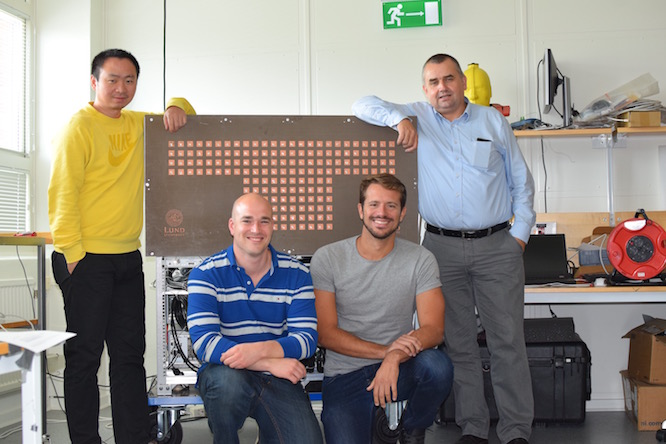
Core EIT-team behind the Massive MIMO LuMaMi-testbed: Senior researcher Liang Liu, PhD-student Steffen Malkowsky, PhD-student Joao Vieira, Professor Ove Edfors. Missing in picture: Professor Fredrik Tufvesson.
Text and photo: Anders Borgström.
EITs 5G Massive MIMO researchers are best in class for sure! Doctoral student Steffen Malkowsky together with his research colleague Paul Harris from University of Bristol grabbed a real grand-slam at the 2016 NI Engineering Impact Awards ceremony in Austin, Texas, in the beginning of August. This event attracted more than 3,200 innovators, with thousands more watching the keynote events around the world over live streaming.
Five awards
Steffen Malkowsky and Paul Harris won first prize in five separate categories in fierce competition with more than 100 other contributions. An absolutely incredible achievement! Steffen together with his Lund team-mates PhD-student Joao Vieira and senior researcher Liang Liu have all worked extremely hard during a long time to develop a Massive MIMO testbed. This hard work is now being so gracefully rewarded for the world record performance in spectral efficiency obtained using the University of Bristol instance of the testbed. Main supervisors of the Lund part of the project are professors Ove Edfors and Fredrik Tufvesson.
The five categories scooped by Steffen and his Bristol colleague Paul were the following:
-NI's Wireless and Mobile Communications category
-NI's Engineering Grand Challenges Award
-Hewlett Packard Enterprise (HPE) Edgeline Big Analog Data Award
-Powered by Xilinx Award
-2016 Customer Application of the Year Award
Fortunately they didn't need any extra baggage allowance on the flight home, since NI gracefully offered to ship the five heavy trophies to Lund after the event. Check the happy team yourself in this award ceremony video.
Spectral efficiency, what's that all about?
What is spectral efficiency? Well it's about what data rate that can be achieved over a given bandwidth in a specific communication channel. Or how efficiently a limited frequency spectrum is used in terms of transmitting data. To put it simple: -How much data can be packed in an existing radio signal.
Spectral efficiency measurement unit is bits/sec/Hz and the competition is about showing the highest values. Steffen and his colleagues have boosted massive MIMO to an incredible world record of 145.6 bit/sec/Hz. Using a 20 MHz channel this means a throughput of 3 Gbit/sec, beating by far both 4G and LTE current performances. The 145 bits/sec/Hz-world record is illustrated in this video brought forward by the team at Bristol University who also issued this pressrelease on the subject.
Ove Edfors in keynote
At the day 2 keynote presentations EIT professor Ove Edfors and Professor Andrew Nix at University of Bristol entered the large NI Week-stage and gave the big audience a brief presentation of the uniqueness of the Massive MIMO system principles and how it's now been showed to perform so well together with key hardware and software components from National Instruments. Among other things, the key-note video informs about Massive MIMO systems usage of not only time and frequency domains but also the spatial domain in order to share spectral resources between different users. The work on designing the massive MIMO testbed has allowed Lund University researchers to publish the first papers on real time Massive MIMO over the air. Real results with real hardware, software and prototypes.
Ove has also earlier made a 2 min excellent video animating and describing the fundamental principles of Massive MIMO using one basestation and three terminals.
Paving the way for 5G
Steffen, Paul, and the rest of Lund-Bristols Massive MIMO research teams are among the most important players in bringing future 5G technologies in place. Next step is to study how the system works when the connected units are mobile. Test will be performed in collaboration with the Bristol-team later on this fall in Lund.
Congratulations to Steffen, Liang, Joao and others involved at EIT!
Erik Larsson på Kunskapskalas
Published: 2016-08-08
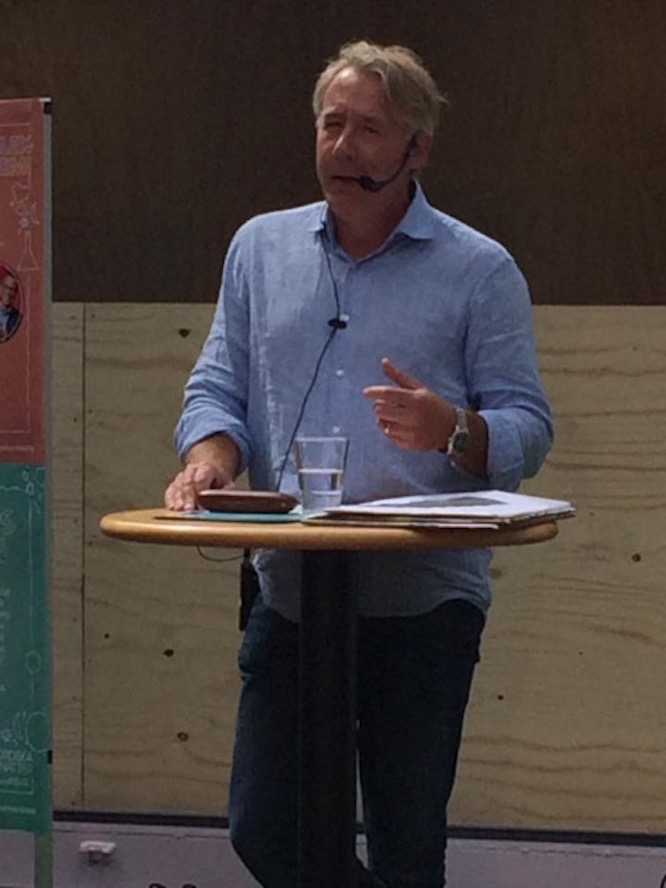
Erik Larsson, docent på EIT, deltog som föreläsare på Folkuniversitets arrangemang Kunskapskalaset under Helsingbogsfestivalen HX16 som gick av stapeln 4-6 augusti. Erik levererade kunskap till kalasande besökare om IT-beroende och dess risker i vårt samhälle. Nuförtiden finns det elektronik inte bara i mobiltelefoner och datorer utan i stort sett i varenda pryl. Självklart vill vi att elektroniken ska fungera så länge vi använder den, men det är inte så enkelt när en enda integrerad krets kan bestå av 10 miljarder transistorer där ledningarna är bara cirka 20 nanometer. Mycket kan gå fel.
Läs mer om HX16
Lund University breaks the world record for transistor performance
Published: 2016-06-23
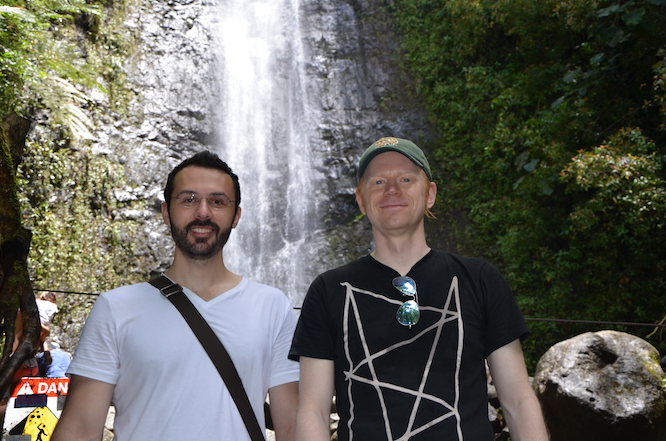
A team from Lund University has developed transistors with a new world record of performance. The improved performance can be translated to a reduction of power consumption in computer and mobile devices, allowing for new features, more memory and longer battery life time.
The transistor is the smallest constituent of computer processors (CPUs) and memories (RAMs), and the continued development of it, since its invention in 1959, has ushered in the digital era.
“The primary transistor performance metric is the amount of current that is able to pass through the transistor under a certain voltage. This, in turn, depends on many factors, such as material properties and device design”, says Cezar Zota, who presented the work together with Erik Lind, at the 2016 Symposia on VLSI Technology and Circuits in Honolulu, Hawaii.
With improved transistor currents, the voltage powering them can be lowered, so that the current falls down to the minimally required level. The net gain is a reduction of the power consumption of the circuit which implements the transistors.
“In our research, we use so-called III-V compound semiconductors, rather than the silicon-based alloys used in industry. III-V materials have the potential of improving transistor performance, but also present new challenges to be solved”, says Cezar Zota.
With these results, Lund University now holds the world record in transistor performance, beating stiff competition from both academy and industry.
Links
Text and Picture: Erik Lind
A new take on asleep and awake
Published: 2016-06-22

-Congrats Nafiseh! You are a doctor! Tell us, did you have a nice party after the duties during the big day? -We had a dinner but no big party. Maybe later... Now it's relax and vacation time. It's been a tough spring.

Preparing for thesis presentation
The field
Assistant Professor Sofie Pollin, KU Leuven, Belgien opened the event and the well attended E:1407 learned that modern wireless sensor devices are often constrained by batteries that determines the size of the device. Even though the nodes in a networked sensing system are mostly asleep and doing nothing, they have to wake up now and then. Waking up and checking activity consumes power which also goes for the processing and sending of data. Finding clever approaches on scalable, powertight wake-up schemes for wireless sensing systems is what our latest doctor Nafiseh Seyed Mazloum has been occupied with in her PhD-research.
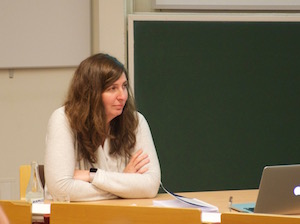
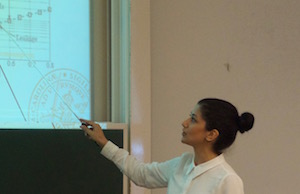
Opponent Sofie Pollin (left) and Nafiseh Seyed Mazloum (right).
Nafiseh presented her thesis "Duty-cycled Wake-up Schemes for Ultra-low Power Wireless Communications" and talked about network topology, data traffic, cross-layer communication protocol solutions and more, all targetting extremely powertight wireless sensing networks.
Dinner talk
Nafisehs approach to describe her research in a popular way is the following:
-Whenever you have a very small resource of anything, you want to use it efficiently. -My research addresses very small devices like pacemakers, hearing aids etc. Things that need to communicate without having a lot of battery. That's what I work on. This way of putting it usually works at a dinner conversation. -It's a bit like telling someone that you should switch off your mobile phone screen to make the batteries last longer. If the listener wants to know a little bit more, I continue with "standby-mode" and explain that entering this is done autonomously and not by a press of a button.
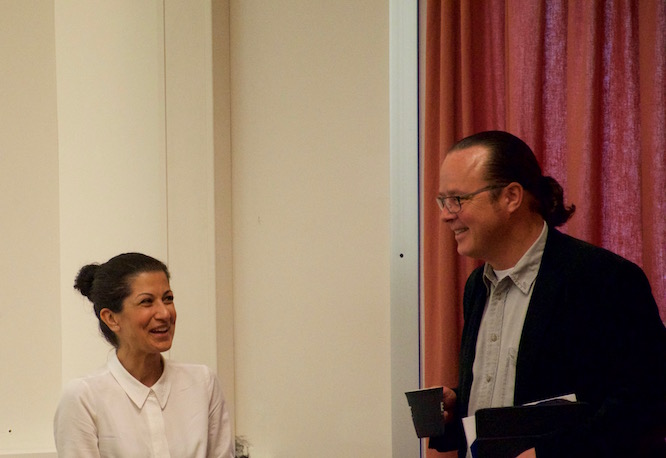
Nafiseh and LTH Dean Viktor Öwall
Tech talk
-DCW, or spelled out as "Duty-Cycled-Wakeup" means that you send your receiver to standby-mode in duty-cycles where it's on for a period and off for another, says Nafiseh. -Waking it up needs to be done autonomously since noone human is there to do so. Energy consumption also relate to communication delay so when sleep-time is long, the communication is delayed. -And duty-cycle settings depend on application and use cases, she tells us.
On the opponents question why a 65 nm process is used to verify the functionality of the circuits and not something more state-of-the art, Nafisehs opinion was clear.
-Well, whether to use older or newer technologies can always be discussed but I used the technology that was easily available at the time of testing. The focus of my particular research was not on state-of-the-art CMOS-technology, rater on proof-of-concept of the wake-up functionality.
From engineering in Teheran to research in Lund
Nafiseh worked as a hardware engineer in Teheran and then moved to Sweden 11 years ago where she did her master studies and PhD. The master thesis however, was performed at Philips research in the Netherlands. It all ended up with a PhD-position at LTH. The background in low-power electronics was a good match for this and Ove Edfors has been her supervisor (a very good one) ever since.
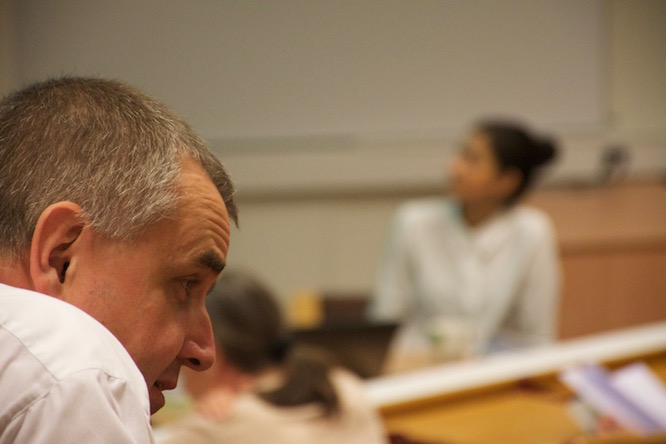
Supervisor Ove Edfors and Nafiseh Seyed Mazloum
Swedish integration going on
Nafiseh is now looking for new opportunities, probably in a research institute or similar. Engineering in industry is over and done with for the time being. -Sweden is nice, I'd like to stay here, she says. -And living in Lund represents a cosy lifstyle. -My swedish will improve now when I've more time, she promises.
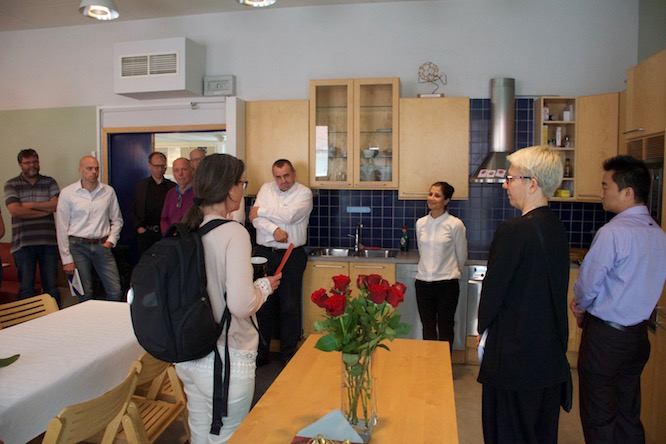
Congratulations Nafiseh.
Art and sport during leisure hours
Any life outside work? -Yes! Painting in watercolour and also consuming any type of art. Visiting Louisiana Museum of Modern Art in Denmark is a must at least once a year. And I do like exercising in any kind of sport even though on an amateur level. But trying to keep in shape is important for me.
Gender balance potential
An encouraging fact with your disputation is that we saw a female opponent, two women in the committee and last but not least you defending your thesis. Pretty good marks on gender balance in this case compared to most disputations in our area! Gender balance is addressed more and more in the society on all levels and we know that there is a lot of talk but not always much walk-the-talk. How would you say LTH/EIT perform? -I've enjoyed my time and colleagues at EIT a lot but we are not champions in this particular sport. Nafiseh ends the conversation by diplomatically mentioning that there is potential to build a good culture here. As long as there is will.
Congratulations from EIT and good luck in the future!
Text and Picture: Anders Borgström
2016-06-17 Master Thesis presentatio by Sebastian Andersson and William Tidelund
Published: 2016-06-15
Date: June 17, 2016
Time: 10.15
Place: E:2349
Title: Adaptive Beamforming for Next Generation Cellular System
The work has been performed at Ericsson AB in Lund.
Abstract
In this work a Matlab model of a simplified LTE system has been implemented. The PUSCH and PDSCH signal chains has been used for reception and transmission of data and DM-RS symbols are used as pilots. Moreover does the model support communication and interference between multiple users and base station antennas. The wireless channels are modeled as multi-path Rayleigh fading and are continuous in time such that multiple frames can be transmitted on a correlated channel. Three standardized multi-path delay profiles have been used for modeling users in pedestrian, vehicular and urban environments. Three beamforming algorithms have been implemented, maximum ratio transmission, zero-forcing and regularized zero forcing. This model is an extension to the current standard of LTE in the sense that the parameters of the model are scalable beyond what is currently in the standard. The different algorithms are compared in many different scenarios, including different modulation levels, delay profiles, number of user sharing the same resources, number of base station antennas, multi-layer transmissions and complexity. Maximum ratio transmission is shown to be computationally much faster , while the zero-forcing algorithms is better at removing inter-user interference, especially as the users sharing the same resources grows for a constant number of base station antennas. Regularized zero-forcing is shown to outperform the other algorithms when looking at the entire SNR range.
Anders Karlsson tar guld i institutionsgolfen
Published: 2016-06-14
Anders Karlsson tar guld i institutionsgolfen
Årets institutionsmästerskap i golf avgjordes torsdagen den 9 juni i strålande sol på fantastiskt fina Erikstorpsbanan, Landskrona GK. Efter en hård batalj kunde fyra medaljörer koras efter förnämliga insatser. De fyra är:
Guld och institutionsmästare: Anders Karlsson
Stora silver: Ulf Körner
Lilla silver: Richard Lundin
Brons: Bengt Mandersson
Några highlights:
Hål 3: Richard sätter en lång putt och får fyra poäng på hålet. Det är dagens högsta poäng. Grattis till denna prestation Richard!
Hål 10: Skyltarna för väganvisningar är inte de bästa och det gör att förvirring ibland uppstår i ledarbollen. I bollen efter ledarbollen går en grupp av fyra damer som från och med hål 10 ser som sin uppgift att hjälpa ledarkvartetten med orienteringen. Så fort tvekan uppstår kommer därigenom en dam resolut rusande över fairway och ger instruktioner. Mycket praktiskt.
Hål 13: Anders slår ut först och får till en lång men mycket slicad drive och hamnar i ett svårt läge, på tok för långt till höger om fairway. Ulf slår ut som andreman och även han slicar grovt och hamnar långt till höger om fairway. De båda herrarnas lägen förbättras dock väsentligt när Bengt förklarar att de slagit ut mot fel fairway. Det slutar med ett par för Anders och en bogey för Ulf.
Hål 14: Birdie från damtee av Ulf Körner! Ulf slår i vattnet på detta svåra par tre hål. Han droppar på damtee, med ett slags plikt, slår upp bollen på green och sätter en 10 metersputt.
Hål 15: Richard hålar ut efter 12 slag. Dagens högsta siffra. Heder åt Richard för att han minsann inte ger upp i första taget!
Efter avslutad tävling avnjöt de fyra pristagarna en fantastisk lunch på Erikstorps Kungsgård med Kokt rimmad kalvbringa med kräm på örter, vårprimörer i dillsmör och potatispuré. Erikstorps Kungsgård ligger i direkt anslutning till golfbanan. Även icke-golfare kan rekommenderas denna pärla.
EIT projektleder open-sourcebaserad innovationsupphandling
Published: 2016-06-03
EIT har tillsammans med LU Open, LU Byggnad, Inköp- Upphandling, MAPCI och Datordriftgruppen deltagit i en för LU unik Vinnovastöd innovationsupphandling. På sikt syftar upphandlingen till att åstadkomma ett open-sourcebaserat system med stor potential att samordna, förändra , förenkla och förbilliga administration och användning av olika organisationers lås- och passagesystem. Två slutkandidater för leverans av skarp prototyp har valts ut, Sensative AB från Lund (Årets skånska startup) och Osser Brosoft AB från Stockholm. Teknisk projektledare från EIT är Anders Borgström.
Mohammed fights low-voltage linearity issues
Published: 2016-06-02

Mohammed Abdulaziz ready for his PhD-thesis presentation
What is it all about?
Mohammed Abdulaziz recently presented his PhD-thesis in an almost full E:1406. The title of his thesis is "Linearity Enhancements of Receiver Front-End Circuits for Wireless Communication" and for those who want to dive deeper into the knowledge he gained during his research-time, a quick glance at the abstract give a hint of what's to be found in the full thesis. The thesis is based on 5 papers covering topics like positive feedback of operational amplifiers, LTE-channel select filters, feed-forward linearization, low noise amplifiers, spectrum sensing and other appetizing stuff.
OK, and what does that mean?
For us "normal" people, not prepared to try to follow all details in the thesis we ask Mohammed about a high-level and more popular description of his area of research and we get the following story:
Demands on high-end wireless handsets (e.g. smart phones) are ever increasing. Fast data transfer, power efficiency and "always-connected" are properties that are regular subjects of improvement and also not to be traded away.
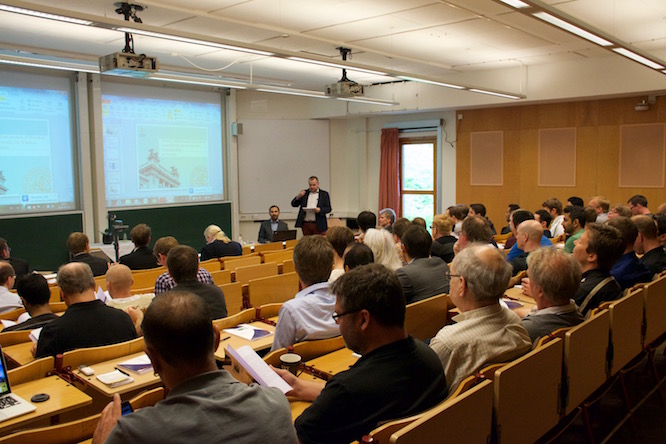
Well attended in E1406
Carrier aggregation is hard
Band fragmentation, where cellular frequencies are divided between different operators, requires sometimes special measures where several narrow channels are combined, called carrier aggregation. This is a complex thing to handle by the hardware.
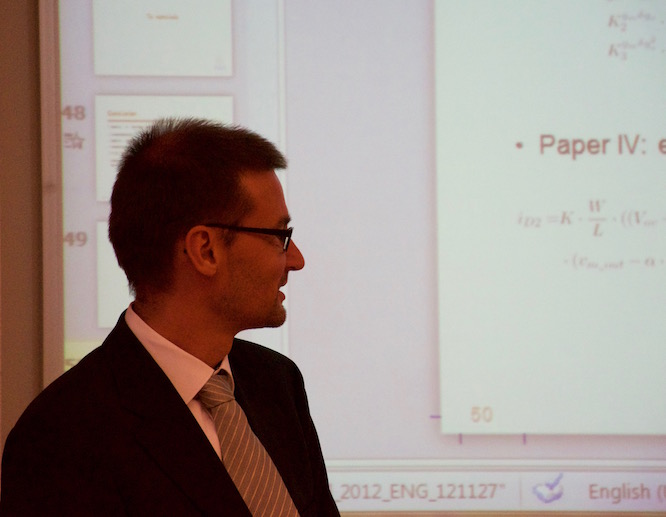
Opponent checking paper four
Linearity issues
To squeeze in more transistors on a given chip-area will mean smaller transistors, lower power consumption, improved speed but also reduced supply voltage. The latter has a negative impact on signal quality because of worse linearity of the transistor in this regions. Higher distortion is inevitable.
Stronger signals taking over
Stronger signals can also saturate the receiver preventing reception of the wanted signal. This problem is similar to trying to listen to one talking while a foghorn is sounding at the same time.
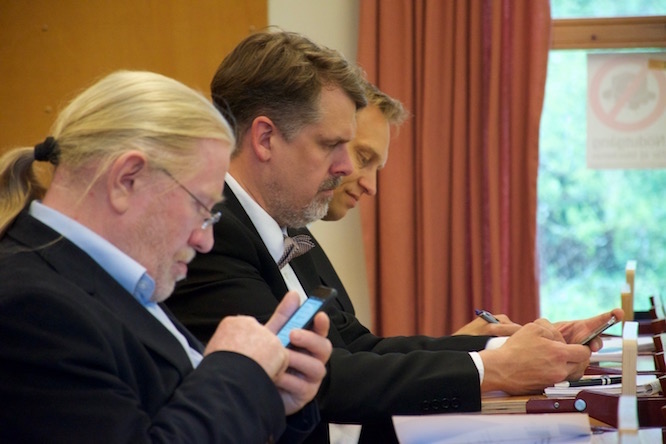
Committee at work
Verify with measurements on chips
Mohammed has addressed the problem of receiving weak signals in the presence of strong interference and three channel select filters are designed and implemented with improved linearity. A full receiver front-end for carrier aggregation with spectrum sensing is also implemented. These solutions are analyzed and simulated, and chips are fabricated and measured to verify the performance and compare to the analysis.
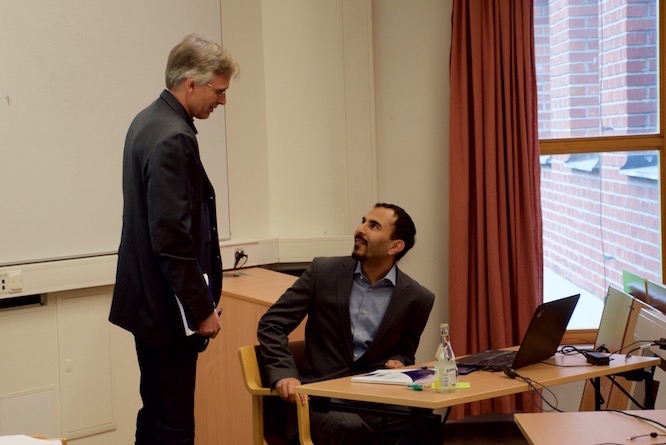
Last minute check
Briefcase guided me to the PhD-track
Since I was a child I have always wanted to finish my postgraduate education, I think my mother was the one who motivated me the most. She promised to give me the leather briefcase when I asked her for it, but “after you finish you PhD” she added.
From Yemen to Lund via Erasmus program
I come originally from Yemen, did my bachelor degree in Jordan. After finishing my bachelor degree I worked for the university in my home town (Dhamar) as a teacher assistant. The Erasmus mundus program started and I was interested in doing my PhD. I saw that Lund University was a partner. I was very interested in LTH because I knew at that time that Bluetooth technology was born in the same department. I applied for my first and second wishes to be LTH and the third one for French university. I think if there was a third option in LTH I would have applied for it as well.

You passed
Future is like good unwritten book.
Currently I am engaged in a project in the department, you will notice I am still around in the lunch room and the research lab. After that future is not so clear but promising.
EIT says congratulations and good luck in the future!
Text and Photo: Anders Borgström
Färs och Frosta’s research prize to Xiang!
Published: 2016-05-27
Färs och Frosta’s research prize to Xiang!
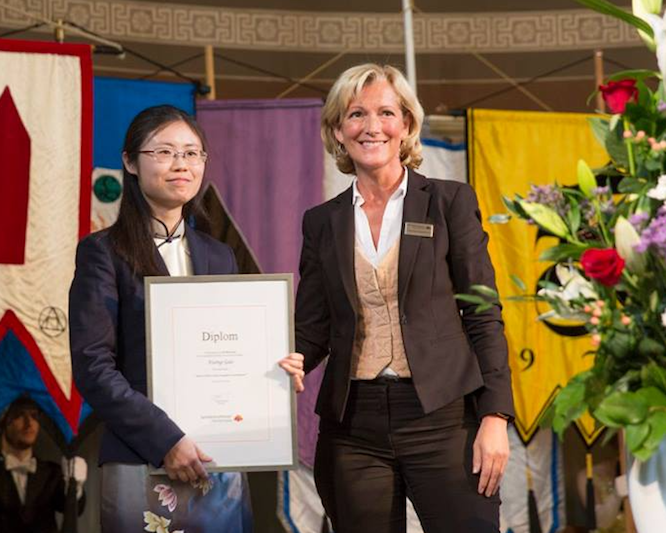
At the new engineering graduates ceremony last week, Sparbanksstiftelsen Färs och Frosta’s research prize went to EITs newly PhD-graduate Xiang Gao. Read more about Xiangs PhD-graduation here and about the prize ceremony here. Congrats to Xiang!
Text: Anders Borgström. Photo: Gunnar Menander
Exjobbare från EIT vinner SER- Prize.
Published: 2016-05-17
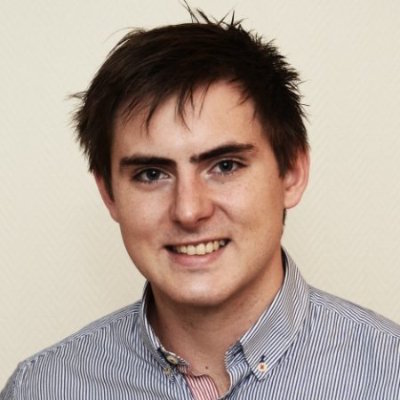 |
... |  |
| Max Andersson | Gabriel Jönsson |
Sveriges Elektro- och Dataingenjörers Riksförening, SER.se, har i år tilldelat sitt SER junior Prize, för årets bästa exjobb, till Gabriel Jönsson och Max Andersson för sitt examensarbete runt en FPGA baserad PCI Express controller med motiveringen: Att kunna styra snabba processer i realtid kommer alltid att behövas inom processindustrin. Handledare var Fredrik Kristensen
Grattis från EIT!
EIT records in spectrum efficiency.
Published: 2016-05-16
The Lund-Bristol team (left-to right): Benny Chitambira (Bristol), Paul Harris (Bristol), Wael Boukley Hasan (Bristol), Liang Liu (Lund), Joao Vieira (Lund), Steffen Malkowsky (Lund), Siming Zhang (Bristol), Mark Beach (Bristol)
Lund University (EIT) and Bristol University together break new grounds in the field of spectrum efficiency with a 128-antenna array in a prototyping platform from National Industries.
Compared to existing 4G-platforms, the team shows around 22 times better capacity using 256-QAM modulation, a shared 20 MHz radio channel at 3,51 GHz and a 128-antenna M-MIMO-array. Eight researchers and postdocs from Bristol and Lund demonstrated this and from Lund Liang Liu, Steffen Malkowsky and Joao Vieira participated.
The team beats their own earlier record and another one from Facebook with 24 users and a 96-antenna array. A 1000 fold increase in netwowrk capacity compared to 4G is claimed needed to meet future 5G-needs. Massive MIMO, mmWave and beamforming are technologies that will contribute and our Lund researchers are key persons.
Jun Wu, a proud nanoelectronic researcher.
Published: 2016-05-10
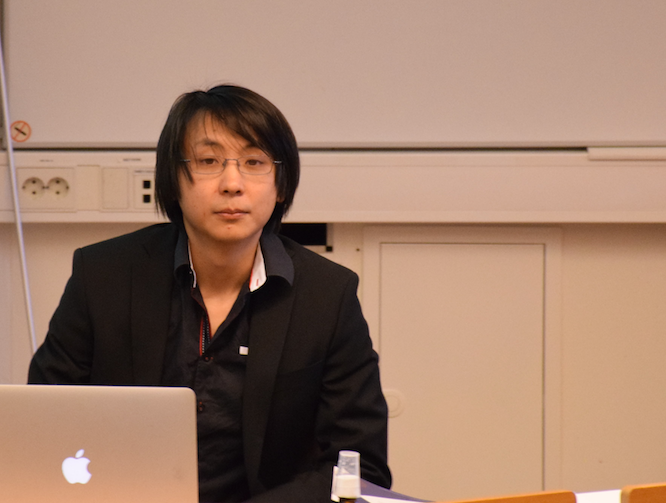
Jun Wu, preparing for his thesis presentation. Photo: Anders Borgström
MOSFET-evolution going nano
-I am quite proud of my research, says Jun Wu who is EITs most recent PhD-graduate. -And my research covered a quite broad area.
In his thesis, titled "Vertical III-V/High-k Nanowire MOS Capacitors and Transistors", you can read that the transistor gate geometry has evolved from planar technology through doublegate-, tri-gate up to what Jun is now studying, namely GAA-technology. GAA stands for Gate-All-Around and using that means a rethink around the most fundamental buildingblock of electronics, the MOSFET.
-In general, we would like to realize a new type of MOSFET using standing III-V compound semiconductor wires called ”nanowire” (below 50nm) and try to further develop circuit implementation using the new type MOSFETs, says doctor Wu. -To do so is beneficial since one can further increase chip packing density and performance, he continues.
Many fields addressed
His research has been involved in several fields as...
...the field of growing nanowire crystals where he has developed recipes to grow defect-free nanowire crystals.
...the field of optimizing the MOS-gate electrode where he realized the detailed characterization and improvement for MOS-gate electrode for the first time.
...the field of fabricating and improving the MOSFET where he cooperated with his colleague to develop new type of nanowire MOSFETs with improved performance
...the field of developing circuit implementation where he realized 3-D cricuit integration along nanowires.
Again, a quite broad area has been addressed.
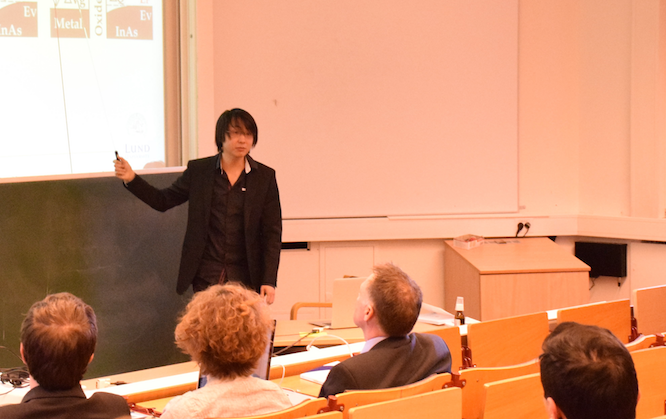
Jun Wu and committee. Photo: Anders Borgström
Research fun but applications also important
-Doing research may be the most interesting job in the world, since you get a chance to work in the frontier of mankind’s knowledge, and try every now and then to make breakthrough out of it, Jun says.
The subject of nanoelectronics is attractive to Jun because it is a branch of the emerging promising nanotechnology topic, and also beause it's closely related to industry implementations rather than pure scientific research. -The practical motivation is a need for me, says Jun.
From China to US via Sweden
Mr Wu, who comes from Beijing in China is interested in reading and traveling and his reasons for choosing LTH is Lund Universitys excellent research reputation within the field of Nano science and technology. -A field I'm interested in, he underlines again.
The future plans includes visa-applications to U.S.A. in order to pursue a post-doc offer by UCSB (University of California, Santa Barbara). Further to that, no longer term plans are in sight.
EIT congratulates and wishes all success in the future.
Text: Anders Borgström
ELLIIT Nyhetsblad 13 ? April 2016 (copy 1)
Published: 2016-04-27
Grand Competitive Driving Challenge 2016REFSQ conference140 character publicationLise Meitner guest professorWASP starts upMassive MIMO as Enabler for Communications with Drone Swarms
ELLIIT Nyhetsblad 13 - April 2016
- Grand Competitive Driving Challenge 2016
- REFSQ conference
- 140 character publication
- Lise Meitner guest professor
- WASP starts up
- Massive MIMO as Enabler for Communications with Drone Swarms
ELLIIT Nyhetsblad 13 - April 2016
Link to the article ELLIIT Nyhetsblad 13 ? April 2016 (copy 1)
Career talk with EITs new professor
Published: 2016-04-12
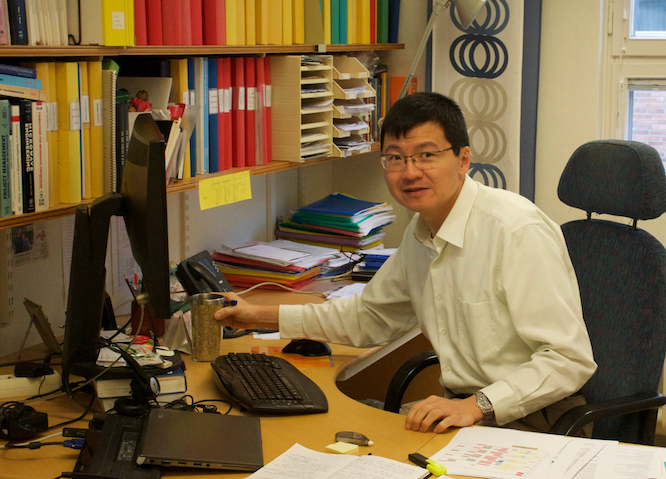
Professor is a useful title
-And a career step which I’m glad to take even though my daily work will not change dramatically. Our new professor Buon Kiong Lau, or Vincent as most of us know him, says he is happy to be promoted as he grabs the coffee-mug and prepares for a chat on academic careers. The importance of reaching the professors level shall not be underestimated. -It is a good statement of qualifications and you don’t need to explain all your merits to everyone, he says.
Vincent realized that he was approaching the professors title around 2012 – 2013 -Enough qualifications and merits in place so I decided to go for it. Guidelines and checkpoints have progressively become stricter and it’s the Deans decision to allow the application by writing a letter of support. After improving a little on lower-level education 2013 the gap was filled.
Why Vincent?
The name Vincent does not appear in either his publications or his passport so why Vincent? -The reason I have this nickname is because my uncle suggested it being born around St Vincent’s day. As simple as that.
Research and education is of equal importance…
He emphasizes the importance of both research and education but admits that research is a little bit more fun. For Vincent, both sides have of course been mastered throughout the years as well as fund chasing, PhD-supervisions, IEEE-editorial tasks, directorship of postgraduate studies and other important duties being expected in higher level work.
…as well as science outreach (tredje uppgiften)
“Science outreach” i.e. how to “deliver” back to society is on the checklist for reaching professors level. Is that close to your heart? -I like to do research that is potentially fulfilling corporate and societal needs and challenges, says Vincent. But if I need to be go into more fundamental research in order to solve a problem, I’ll do it. Fundamental insights are necessary to be able to do more applied research.
Advice to a graduate
-A masters student that really enjoys the master thesis work will most likely be a suitable candidate for an academic career, Vincent let us know. You need passion for writing or at least consider it to be a natural part of the job if the academic world should be enjoyable. A potential PhD-students need to have a good attitude to research and if you can’t handle a 5 month project (Master Thesis) then you will not survive a 5 year research project.
All career steps count
In hindsight, which step in your academic career would you value the most? –Hard to say since every stage has its value, Vincent says. But my new role will hopefully mean more scientific leadership. My current research field is neglected by funding agencies.
Learn from Spain and Italy
What about gender balance among electrical engineering? –Well, I do my best in encouraging female students, says Vincent. -My first PhD-student was female and so many of the visiting students I have supervised. So I think my track record is pretty ok in that respect. –But even though equal opportunities, it takes time to change cultures, traditions and attitudes. Ending up with 80% male student buddies by selecting an engineering track may prevent many from choosing it. And role models matter. If mums, aunties and friends are not engineers, perhaps a young woman hesitate. –We could learn from Spain and Italy, Vincent suggests. They have a lot of female electrical engineers for some reasons.
Performance and design must walk hand-in-hand.
Also consumers needs to be enlightened in Vincents opinion. -We choose phones based on look and feel rather than on performance, he says. 2 Mb/s instead of 20 Mb/s seems to be ok for many as long as the phone is shiny with cool apps. As a professor I’d like to engage more in this and promote in a more balanced way. Design yes! But also perfomance, yes!
A bad antenna destroys a system
Antenna systems including interaction between antennas and the channel and focus on system performance has been Vincents silver thread in his research. His background in signal processing enables another important building block in achieving better data rates and throughput. Failing terminal antennas may destroy a 5G-performance. –We are benchmarking very well, claims Vincent. Close collaboration with propagation channel research projects and good experimental facilities makes EIT an excellent research environment within the field.
From Malaysia to Lund via Australia and Blekinge
Born in Malaysia and studying in Australia for 10 years took Vincent to Blekinge and then eventually as a postdoc. -Sweden is a good place to have a family and good career opportunities, says Vincent. The sometimes bad weather is nothing fixable so we just have to accept it.
Vincents spare time is mostly spent on his family with 9, 6 and 3 year old kids. Boy, girl, boy. Will some of them become engineers? –My oldest son is interested in technical things. There’s hope…
How to save the world with 10 dB
Asking Vincent finally about long term visions for the world we get an engineers answer: 10 dB improvement can be easier to achieve with an excellent antenna design than 1 dB with signal processing. Wise words from our new antenna professor.
Congratulations from EIT!
Text and photo: Anders Borgström
New world record in 5G technology
Published: 2016-03-24
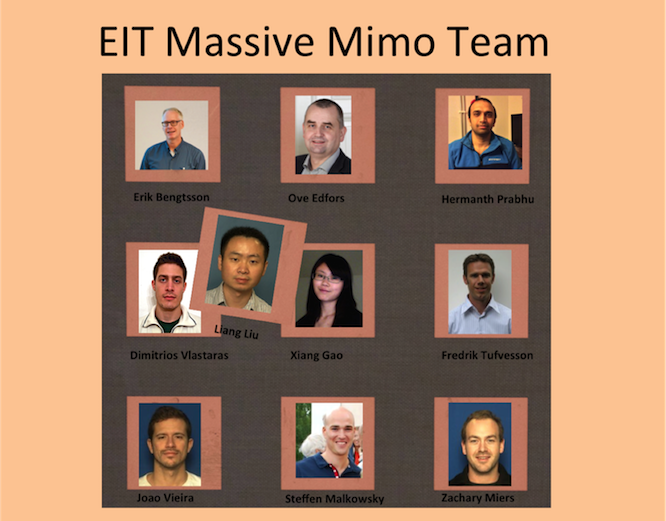
New research conducted at Lund University in Sweden and the University of Bristol in the UK has demonstrated 5G technology twelve times as efficient as the current 4G technology, paving the way for the mobile systems of tomorrow.
Researchers in Lund and Bristol have made enormous progress with their work on Massive MIMO (multiple-input multiple-output) – a technology which, in simple terms, consists of equipping every base station with hundreds of antennae instead of the few they currently have.
“What we have developed is an extremely efficient 5G technology. We have actually found the most efficient technology ever in terms of capacity to handle many users simultaneously. What is really new here is that it has been demonstrated in practice that this fantastic spectrum efficiency can be achieved.”, says Ove Edfors, Professor of Radio Systems at Lund University’s Faculty of Engineering.
The research findings on more efficient mobile systems are the result of a collaboration, explains Edfors’ colleague Fredrik Tufvesson:
“This progress is based on work conducted over several years at Lund University, with our doctoral students and together with partners such as the University of Bristol, Linköping University, and within the MAMMOET EU project.”
The next generation of mobile technology, 5G, is under development and the research on Massive MIMO is an important contribution to this.
“Lund and Bristol are now breaking world records in efficient 5G networks, or in spectrum efficiency to be precise”, says Professor Fredrik Tufvesson.
More on LTH homepage
Xiang brings massive MIMO into real life
Published: 2016-03-22
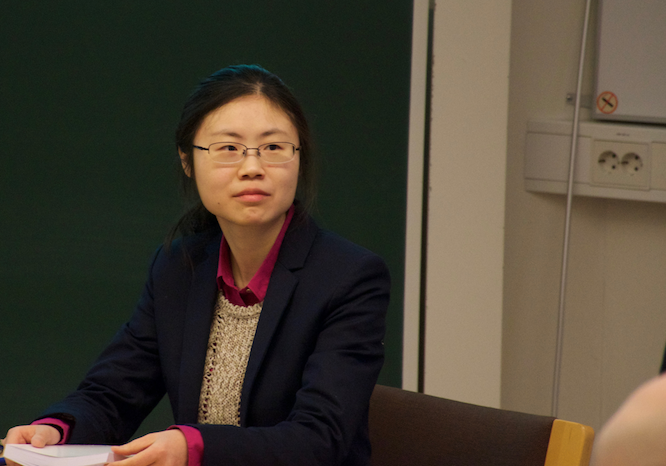
EITs latest doctor is Xiang Gao and the title of her thesis is “Massive MIMO in real propagation environments”. In her research she has contributed to the extension of the MIMO technology where cellular basestations or WiFi hotspots can be equipped with tens to hundreds of antennas. The advantages are much higher data rates, better coverage and less radiated power, as compared to any of today’s communication systems. It is believed by many people as one of the most important technologies for future communications.
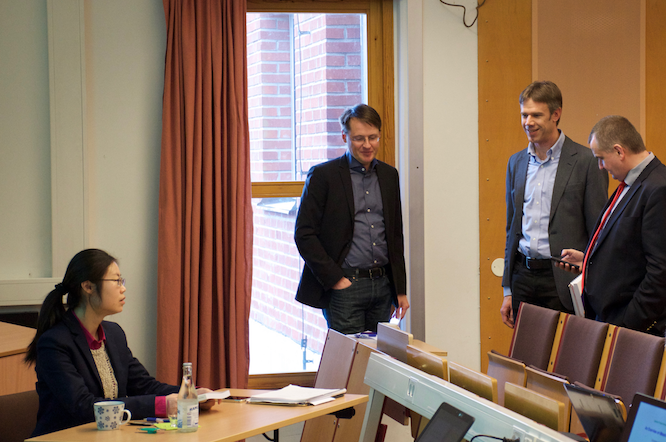
Xiang Gao final tuning with chairman Mats Gustafsson and supervisors Fredrik Tufvesson and Ove Edfors
Xiang has stepped out from the theory-domains of massive MIMO and into reality where channel measurements in the 2,6 GHz band have been performed. She has seen that the technology works efficiently in real propagation environments, something that looks very promising for the future.
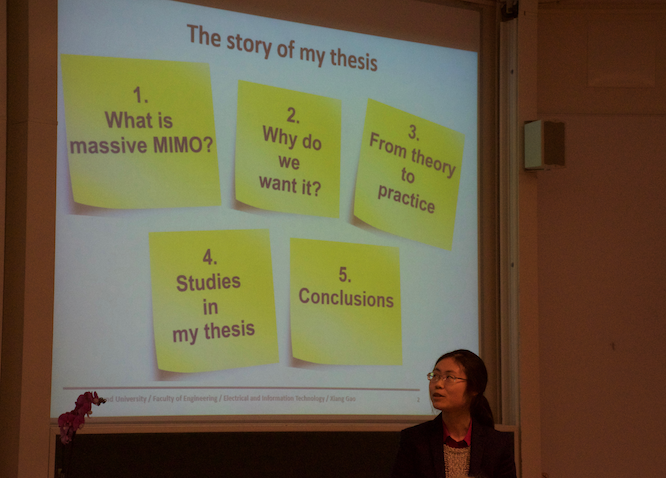
Xiang Gao lines up her PhD-thesis presentation
The PhD-studies were chosen because Xiang desired to stay in the university environment instead of going to the industry. -More freedom to do interesting things here, says Xiang. -I like to exploit many hidden possibilities offered by such freedom, rather than being restricted to dig deep into only one point.
Xiang was born and raised up in Chengdu City, the capital of Sichuan Province in southwest China.
-Because of the beautiful landscape in Western China, I love outdoor activities such as hiking, mountain climbing, photographing, and painting, says Xiang. After moving to Sweden, she became more inclined to indoor activities such as reading, classical music concert, and opera, simply due to the long and cold winter.
Xiang came to LTH, because the master program admission only required IELTS test scores, no TOEFL, no GRE, as in the U.S., so she could spend time doing other interesting things instead of preparing for hard exams. -Other factors that attracted me to study in Sweden include its strength in the ICT industry, indie music, and art design, she says. -My childhood memory with the story book “Nils Holgersson's wonderful journey across Sweden” also added to my curiosity to see this country.
-The best thing during my PhD time is that I have met some very excellent people, here in Sweden and also elsewhere in the world, says Xiang.
Future? –Well, I do not really have specific plans for the future. If there is a “plan”, I would say, doing things that are 1) interesting to myself, 2) valuable to other people, and 3) influential to our world.
-Anything fits at least one of the three can potentially be my future plans, no matter where I am and how old I become.
Xiang values broad knowledge and visions as a very important aspect in her life, so restriction to the area of communication technology is not a must.
-As I always say to my family and friends, the earth is just a small planet in the universe, but our world is very big and has unlimited dimensions. -However, sometimes I feel a bit sad about the future because as human beings we are always time limited: only 24 hours per day, and at most living for 100 years.
All the best and good luck in the future from EIT!
Text/Pictures: Anders Borgström
New PhD course in MIMO Channel Modeling
Published: 2016-03-09
New PhD course in MIMO Channel Modeling
The course will cover the first few chapters of the following book:
Title: MIMO Wireless Networks (Second Edition), Channels, Techniques and Standards for Multi-Antenna, Multi-User and Multi-Cell Systems.
Author(s): Bruno Clerckx and Claude Oestges
Prerequisite: Basic understanding about wireless channels on the level of the "ETIN10 Channel Modelling for Wireless Communication" course is required.
Course format:
- One lecture per week (throughout April and May)
- Matlab assignments
- 7.5 hp.
A tentative starting date for the course is Tuesday, April 5th. The time and place will be decided later.
If you plan to take this course (on a Credit or No Credit basis), please email Ghassan Dahman.
EU project INSIGHT kicked off
Published: 2016-03-01
EIT at the helm of EU-funded III-V project
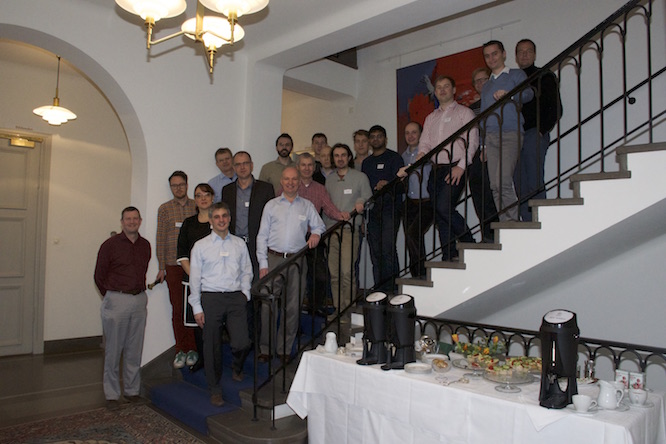 The core team of EU-project INSIGHT at the Kickoff-meeting in Biskopshuset, Lund. The project is coordinated by EIT and professor Lars-Erik Wernersson. Photo: Anders Borgström
The core team of EU-project INSIGHT at the Kickoff-meeting in Biskopshuset, Lund. The project is coordinated by EIT and professor Lars-Erik Wernersson. Photo: Anders Borgström
2016-03-02, By Anders Borgström
-We form a dream-team for future semiconductor technology, says Lars-Erik Wernersson, professor at EIT in Lund. The six partner project INSIGHT, coordinated by Lars-Erik, will address integration of III-V semiconductors on silicon aiming to boost future logic and RF-circuitry performances at low cost and low power consumption. The research team was recently granted a 3-year funding from the EU Horizon-2020 program.
In the beautiful tradition-laden environment Biskopshuset in Lund, an important first step was taken towards new more advanced building blocks for future electronics. The researchers in INSIGHT had their kickoff-meeting and will from now on study how to improve performance using so called III-V nanowires integrated on traditonal silicon platforms. Combining the two worlds of silicon and III-V substrates is believed to have a huge potential in terms of high performance, low power consumption and low cost.
Pressrelease today
A website is newly launched by administrative project coordinator Anna Ntinidou and the official press-release for the project can be read there. And a nice logo will also come in place soon.
In todays press release, the six partners are presented being Lund University in Sweden, University of Glasgow in Scotland, Tyndall National Institute on Ireland, Fraunhofer Institute in Germany and LETI Institute in France. Also IBM in Switzerland are contributing with their technology.

INSIGHT-partners discussing startup strategies. Photo: Anders Borgström
Internet of Things and Big-Data will benefit
Getting e.g. leakage currents down is a possibilty with III-IV technology which in turn could have a huge impact on global energy conservation when the implementation scales up and enter into devices and infrastructure of the future. As we all know, a massive growth is expected within the electronics industry when billions of things (IoT) will be connected and huge amount of data (big-data) will be transferred, stored and processed. Environmental and climate workers will cheer the groups results, for sure.
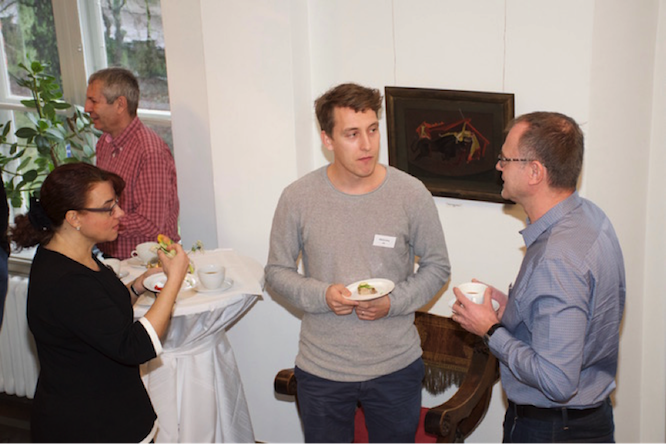 Discussing INSIGHT-preconditions at coffee break in Biskopshuset. Photo: Anders Borgström
Discussing INSIGHT-preconditions at coffee break in Biskopshuset. Photo: Anders Borgström
Kick-off meeting at Biskopshuset
The first outlining of this large EU-financed project was made at the Lund kickoff meeting back in January. The industrial and academic partner’s scientific backgrounds were all shared within the core group and a firm starting point for the project was defined. Work packages, coordination, critical issues, action points and more were discussed as well as how to communicate coming research findings. A first promotional video on YouTube is already in place desribing the technology aims for a wider audience.
Coordination with other EU-consortia like III-V MOS, COMPOSE, E2SWITCH is another important activity where future ties will be developed. Also plans on IPR (Intellectual Property Rights) and how to exploit the research results will get early attention and involve all partners. All this to secure a research direction with large potential to meet future business- and societal needs and challenges.
An industry workshop will be formatted to be executed from year two and early planning for that is also needed in order to sort out content, targets, invitations, conference-links and more.
Kick-off dinner for the INSIGHT-project at Pelarsalen.
A lot of work is coming up for the newly formed team and a get-to-know-each-other-better dinner was arranged day one of the kickoff in order to create good preconditions for future collaboration.
EIT says good luck to the INSIGHT project.
Nice 5G-reading with the morning coffee
Published: 2016-02-22
The swedish magazine "Elektroniktidningen" had EITs Massive MIMO-project represented on its cover and a deeper article inside in their latest February-issue with a theme of communication.
Fredrik Tufvesson, professor in radio systems at EIT/LTH together with professor Erik G Larsson, professor and head of the department of Communication systems at Linköpings University, give the story of their contribution to the Massive MIMO technology and coming 5G-systems.
The collaboration is a big success and the teams complete each other well where Linköping mainly do capacity analysis, protocol design, signal processing whilst the Lund-teams focus is on algorithm design and experimentals. The article describe how EITs nowadays well known testbed LuMaMi is brought forward together with National Instruments and Bell Labs. The testbed is today involved in lab-demos of videostreaming but will during the emerging spring enter into a more basestationlike installation at a rooftop.
Elektroniktidningen is the main news source for professionals in the Swedish electronics industry.
Text/Photo: Anders Borgström
Messaging texts for LU 350-year anniversary
Published: 2016-02-02
Lund University Communications Unit has developed message texts for the upcoming 350 - year anniversary and the texts are meant to support when it comes to communication around the anniversary.
The texts are available for download here. LU encourage the use and dissemination of them -on websites, in catalogs, in printed material and anywhere where they may seem to fit.
The document contains a short and a longer general text of Lund University's 350-th anniversary and the overall message. These are meant to be used as support when the jubilee shouldbe described and can be used as is or customized to specific target groups.
For questions, please contact Magdalena Stadler , Communications , LU350 - Jubilee Offices ,Tel : 0706-41 35 51st
And the winner is...
Published: 2016-02-01
...Acconeer and research from EIT!
|
|
|
Left: The management team of Acconeer, CEO Lars Lindell with co-founders Mats Ärlelid and Mikael Egard. Right: Lars-Erik Wernerssons team is behind the Acconeer-technology
Last week, the EIT-related startup company Acconeer got the reward "Guldmobilen" in the cathegory "Innovation of the year 2015” at the Swedish Mobile Awards Event "Mobilgalan" in Stockholm. The Acconeer innovation has been presented earlier at the EIT-website and originates from research performed at the department. It's a perfect and attractive inspirational example for those students and researchers who are interested in finding future business potential from ongoing research.
Acconeer have developed a microradar that opens up a new world for human interaction and future applications are envisaged in e.g. home robots, drones, surveillance or other areas where there are requirements to measure distance or detect proximity. Other fields interested in adopting Acconeer technology are monitoring vital life signs such as breathing rate and pulse rate. The sensor’s radiowave will penetrate light material such as clothing but not skin and be able to measure breathing rate or pulse therefore it can be used for a multitude of health care and sports applications. And much more. The sky is the limit!
Mobilgalan - The Swedish Mobile Awards - turned 15 this year and have rewarded mobile innovations, products, services and companies every year since 2001. Some memorable earlier winners are King, Swish, Skype, Spotify, Minecraft, all swedish startups who have left a great footprint in global business.
EIT Congratulates Acconeer and wish all the best in future ventures!
Text: Anders Borgström
EIT researchers standing up for Massive MIMO technology
Published: 2016-01-13
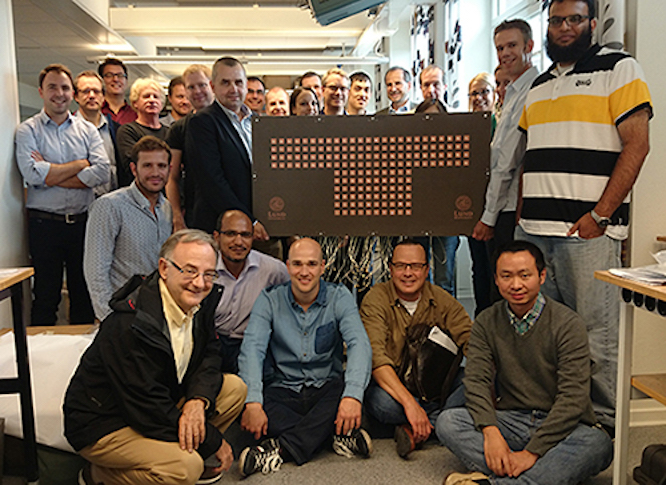
In response to a series on "death of 5G", in IEEE ComSoc Technology News, the MAMMOET project team decided to contribute to its resurrection. Their response was well received and the Editor wrote: "After our doom laden 'death of 5G' series we did get some letters. In particular, the good people of the MAMMOET project in Europe managed to hit several points at once." Read the full story here.
ELLIIT Nyhetsblad 12 ? December 2016
Published: 2016-01-08
The Future of ELLIITThe Wallenberg Autonomous System Program (WASP) startsLund University Robotics Week, November 23-27 2015Positioning using Massive MIMOBronze medal to JaCoPLiU-CVL's visual object tracking method SRDCFRobot Gift WrapperSome...
- The Future of ELLIIT
- The Wallenberg Autonomous System Program (WASP) starts
- Lund University Robotics Week, November 23-27 2015
- Positioning using Massive MIMO
- Bronze medal to JaCoP
- LiU-CVL's visual object tracking method SRDCF
- Robot Gift Wrapper
- Some Publications
- Keynotes and Invited Talks
- Program chairs and Editorships
- Some new dissertations
- Research fundings
ELLIIT Nyhetsblad 12 ? December 2015
